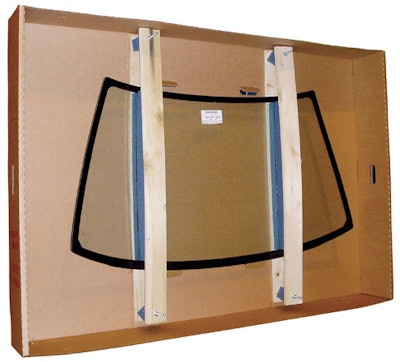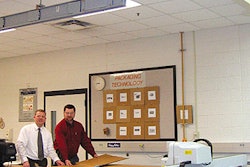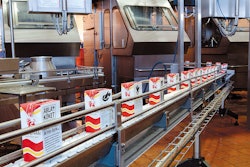In 2001, Dave Allison, a packaging assistant manager for American Honda Motor Co., Troy, OH, recognized a need to reduce damage rates on deliveries of windshields to AHM dealers. Improvements in shipper packaging design were crucial to solving the problem.
Enthusiastically confronting the challenge, Allison proceeded to identify the specific weaknesses in the current design and then evaluated 14 alternative glass packaging styles over an eight-month period.
Analyzing the problem
The old windshield packaging design incorporated three different sizes of corrugated boxes with multiple foam and corrugated board inserts. Triangular corrugated components were used to support the bottom of the glass, and foam slabs were used on the sides and top of the package to secure the position of the glass in the center of the pack. Any dead space at the top of the box was filled with buildups of additional corrugated board pieces.
This packaging method relied on the experience and aptitude of the pack assembly personnel to ensure that the proper box sizes and dunnage (protective packaging components such as corrugated mats and foam cushions) were used to pack each windshield size and style. Because of the variety of choices for boxes and dunnage and the varying inventory levels of these packaging materials at the pack sites, the windshield packs lacked consistency.
A close analysis of the old pack style also revealed that the interior dunnage did not properly support the glass in a vertical drop—which was responsible for an estimated 98% of windshield shipment damage. All these problems combined to result in an annual OAR (Order Adjustment Record) rate of 7.6%. OAR is the measurement AHM uses to gauge the number of orders to their dealers that must be adjusted because of underages, overages, damage, wrong parts, and so on.
New pressure-regulated design
After intensive study of various packaging designs, Allison created a concept he calls “pressure-regulated” design. As he explains, “Rather than supporting the glass on its edge, which makes it very susceptible to damage, the glass is suspended by pinching the windshield between two foam pieces with a light-tack material. The foam pieces then are reinforced by wood bracing. In this method, vertical force vectors are displaced into frictional energy rather than gravitational kinetic energy.”
A single corrugated box structure can be used for all shapes and sizes of glass, providing packing consistency, quality, and efficiency. The pack assemblers only need to center the glass within the box. After that, all packing procedures are the same for each windshield.
Allison notes, “We use corrugated and foam suppliers all over the nation to reduce transportation costs and better service each parts center more locally.” He adds, however, that one of the major corrugated suppliers is Menasha, and one of the major cling foam suppliers is Gaska Tape, Inc.
The packing kits are put together at several regional AHM locations and sent to 10 AHM parts centers and four glass supplier locations. The kit form ensures that all components are readily available for each application.
Allison points out, “In order to ergonomically pack with this method, we have designed packing stations at easy-to-use heights and equipped them with electric drills and pneumatic staplers.”
Lucrative bottom line
The pressure-regulated pack materials cost approximately 15% more than the previous shipper pack materials. But AHM estimates savings of more than a half-million dollars annually in costs associated with windshield shipping damage. Before the changeover, some AHM parts centers were experiencing damage in excess of 20% during some months. The damage rate now is about 2%.
Covered under three separate patents, the pressure-regulated design has earned Allison the Honda Inventor Award, making him the first American Honda associate ever to receive that honor.



























